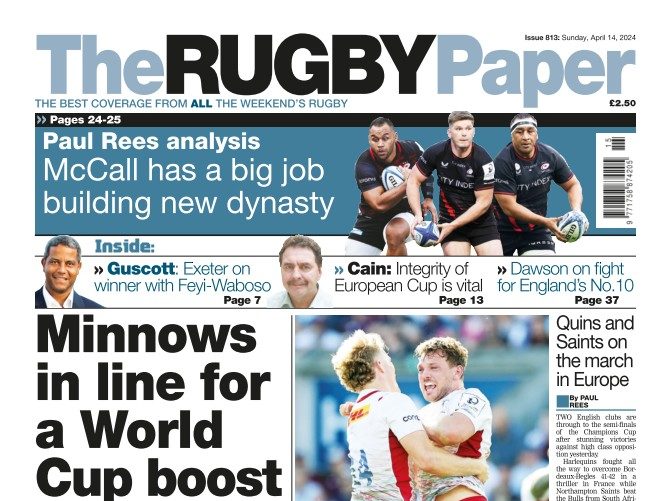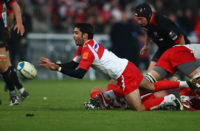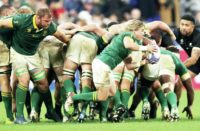CHRIS HEWETT

Spike Milligan, comedy goldsmith and undisputed grandmaster of nonsense verse, counted rugby among the great loves of his life. “The thing that thrills me most,” he once said, “is the sight of a little bugger leaving a big bugger face down in the mud.” Which was rather poetic, after a fashion.
To the best of our knowledge, Wilfred Owen was a different chap entirely. The literary laureate of the Great War was certainly a different kind of poet. Yet more than once down the years, rugby folk have borrowed his celebrated line about “mystery and mastery” in their attempts to capture the essence of a special player – usually a No.10 of the dimensionally challenged variety.
As often as not, Barry John of Wales was the man under discussion. When it wasn't “The King”, it was his countryman Phil Bennett, whose claim to the throne was every bit as legitimate.
“Benny” was blessed with a talent that took him above and beyond the confines of the union game.
Both men had “mastery” in abundance: they had all the skills, all the technique, all the understanding.
When we come to the “mystery” bit, things are a little more nuanced.
When John was in his pomp, opponents knew what he was likely to do but couldn't work out how he did it.
With Bennett, no-one – least of all the big buggers – knew what he would do in the first place. Or where. Or when.
At times like this, when the mind's eye looks backwards and the nostalgia descends upon us like a mist, we are tempted to wonder whether today's rugby stacks up against the version we were watching and playing yesterday. Does the sport still have a place for a Phil Bennett, 11st dripping wet and a picture of frailty, or are we lost in a land of ogres and behemoths?
There is still plenty of “mastery” out there. More of it than ever, possibly. In the recent tradition of Jonny Wilkinson, whose kicking, both from hand and from tee, was as good, if not better, than that of any previous 10, and whose tackling was unprecedented in its strength and reliability, Owen Farrell has precious few weaknesses when it comes to “closed technique”.
But listen to Wilkinson's mentor, Rob Andrew, who knows a thing or two about the subject. “Jonny had all the skills, technically speaking, but he didn't quite have all the gifts,”
Andrew wrote in 2017. “In the art versus science debate…it's clear that he would be placed – and would probably place himself – in the techno-mechanical column.”
It may be slightly unfair to place Farrell in the same bracket, but not wholly. Along with Handre Pollard and host of others at club and international level, he is more associated with percentages and processes than he is with wit and daring and the spirit of adventure. In short, he is not capable of “anything” in the way Bennett was.
But all is not lost. We still have Beauden Barrett and Finn Russell and Quade Cooper. We still have Marcus Smith and Romain Ntamack.
These outside-halves are heavier on the “mystery” – there is no shortage of derring-do about them when they attack from their own dead-ball line – than they are on certain aspects of the “mastery”.
All of which makes the modern game more fascinating than its fiercer critics are willing to acknowledge. Was Barry John really a more complete playmaker than Daniel Carter? Let's put it this way: if “The King” had been in Wellington for the New Zealand-Lions Test in 2005, he would have been as spellbound as any of us by Carter's performance.
Another, more controversial notion: was “Benny” a tougher proposition for opposition defences than, say, Danny Cipriani in the days before the great lost talent of Red Rose rugby picked up an injury that cost him the yard of pace that, on top of all his other virtues, made him a box-office gift from the Gods?
Bennett was patently more singleminded, more dedicated to his craft and temperamentally better equipped to extract every last drop of value from his talent. Yet while his longevity, allied to his many triumphs, elevated him into a different league entirely, he would have been the first to salivate at Cipriani's dynamic range, even if he WAS a bloody Englishman.
And of course, it is well worth remembering that in the 1960s and 70s, not every international 10 was a Barry or a Benny. There were plenty of slow, predictable, clodhopping outside-halves around, both in the old Five Nations and further afield.
In mourning Phil Bennett, we can surely say two things: that while he was very much a sportsman of his generation, the timelessness of his skills and instincts would have allowed him to prosper today as a bulked-up version of himself; and that his spirit lives on in the Barretts and Russells and a select group of fellow 10s prepared to ransack their rugby imaginations for fresh ideas.



























